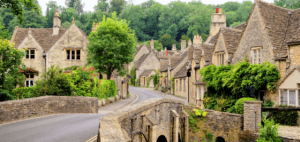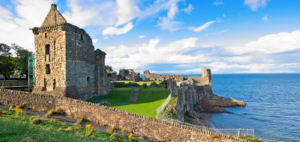Top Things to Do in Garden City, Cairo
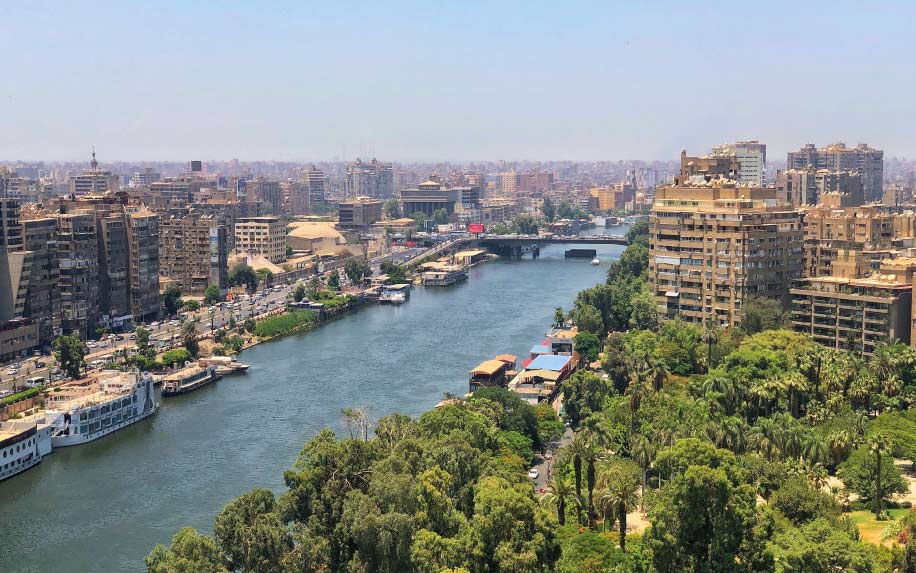
Updated On: March 21, 2024 by Dina Essawy
Garden City is a very prestigious neighborhood in Cairo, Egypt. It was founded by Khedive Ismail, near the Semiramis Hotel, so that the upper class of society could live and he could host foreigners for the historic inauguration of the Suez Canal.
The district is home to many foreign embassies, such as the embassies of the United States, Britain, Canada, and others. It also includes a rare group of palaces and villas with unique and rare architectural designs.
In ancient times, Garden City was submerged under the waters of the Nile, so Sultan Al-Nasir Muhammad bin Qalawun (1285-1341), the ninth Sultan of the Mamluk Bahri state, turned it into a large square known as al-Midan al-Nasiri. He placed trees and roses in it and turned it into a park for people. Horse shows were held in the square that King Al-Nasir was passionate about raising.
In this field, huge horse races were held, and every Saturday and for two months after the day of Wafaa El-Nil, Al-Nasser would ride his horse from the mountain castle surrounded by many knights in the most beautiful outfits and go to the field amid chants from the Egyptian people.
King Al-Nasir once wanted to erect a building there, and they scoured the mud until a hole was formed and it turned into a pond, which is now the Nasiriyah pond.
The site in which the Garden City neighborhood was located was within a place known as Basateen Al-Khashab. The old neighborhood was in the area between Al-Mubtian Street, Al-Khashab Street, Al-Burjas, the Nile, Al-Qasr Al-Ainy Hospital, and Bustan Al-Fadil Street. After that Al-Khaleej Street was divided into two parts, the eastern section was between Al-Munira Street and the Gulf. Its name was “Al-Marais”, and the western section was between Al-Munira Street and the Eastern bank of the Nile.
Things to Do in Garden City, Cairo
As one of the most affluent areas of Cairo, there are countless exciting things to do in Garden City. Here is a selection of our favourites.
Boat Rides
One of the best things to do in Cairo, especially in the summer, is to go out on a felucca, Egypt’s ancient form of sailboats, and have a picnic right on the Nile. There are several felucca docks in Garden City, across from the Four Seasons where you can go for a ride for around EGP 70 to EGP 100 per hour.
This way, you can enjoy a delicious meal as you admire the Cairo skyline and many of its famous attractions from a different vantage point.
Beit El-Sennari
Beit El-Sennari was built in 1794 by a Sudanese occultist called Ibrahim Katkhuda El-Sennari, and it was home to many French artists and scholars after Napoleon arrived in Egypt. The house is now affiliated with the Bibliotheca Alexandrina, which is based in Alexandria.
It is open to the public to attend the numerous artistic events and workshops that are held there. You can also walk around the courtyard and open gardens, and the various sections of the house to admire the artworks on display.
Take a Walk by the Corniche
Take an evening stroll along the Corniche up to the Qasr el-Nil Bridge, where you can admire the famous lion statues at the foot of the bridge. The bridge is a popular spot among young couples where they can sit for hours admiring the beautiful view and buy some roasted lib (peanuts, pumpkin seeds) in small paper cones and hot sweet tea.
Have Dinner on a Cruise or Scarabee
From 8 pm to 10:30 pm, you can book dinner and a show on a cruise or scarabee that not only offers you a delicious dinner, but a great view of the Nile as the boats or ships take you on a two-hour trip along the water.
You can also put on a performance by singers and dancers for the night.
Walk around Garden City
Take a walking tour around Garden City and admire the architecture of its famous historic buildings, villas, and streets that were once home to the crème de la crème of Cairo. The British Embassy on Ahmed Ragab Street was built in 1894, and the Grey Towers Building at 10 Itihad el Mohamyeen el Arab St was also dubbed as 10 Downing Street as it was the British Army’s headquarters during World War II.
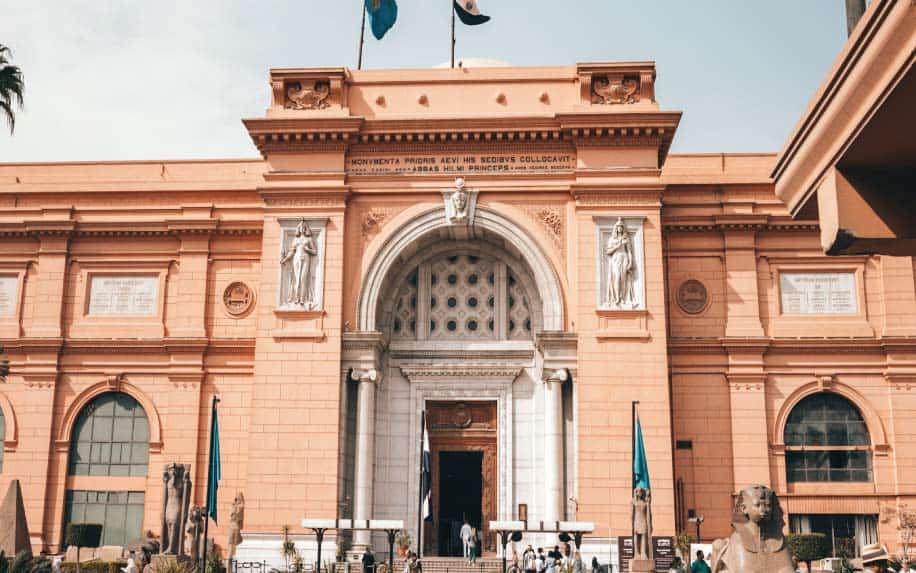
Spencer Davis
Visit the Ethnographic Museum
The Ethnographic Museum was inaugurated in 1895 at the Egyptian Geographical Society, which was founded by Khedive Ismail in 1875. The museum’s collection includes valuable objects depicting the life and customs of the people who lived around the Nile Valley collected by the expeditions sent by the Society to discover the Nile sources. There are also rare photographs and objects from the 19th century, depicting everyday life in Sudan.
The museum is divided into six sections. The first section is dedicated to Cairo with objects from the 18th, 19th, and early 20th centuries. The second contains traditional crafts that have become extinct today. The third section has furniture and objects from an upper-class house in Cairo.
The fourth section holds objects used in the daily life of the rural population in the Egyptian countryside. The fifth section is dedicated to Africa and the Nile Valley, with a valuable collection of weapons and musical instruments as well as a large collection of photographs. The final section focuses on the Suez Canal.
Today it is one of the top landmarks in Cairo.
The museum opens from 8:00 am to 5:00 pm, and is closed on Fridays.
Marvel at the Dobara Palace Church
In January 1940, a new church was established in Cairo, provided that this church would meet in the hall owned by the Nile Mission Editorial House in central Cairo. Reverend Ibrahim Saeed, the preacher known for his beautiful sermons at that time, was elected as pastor of this church in March of the same year. Attendance in this new church increased to the point that the need for a large building became necessary. In 1941, a palace was bought in what is now Tahrir Square, to be demolished and replaced with a church.
The palace contained a beautiful garden. King Farouk, King of Egypt at that time, authorized the building of the church on March 11, 1944, after he was asked by his private mentor, Ahmed Hassanein Pasha, who, like Farouk, had studied in England where he lived in the house of Reverend Alexander White, the great preacher, and writer of many books on the characters of the Bible.
After Dr. White passed, his wife came to Egypt where she met up with Ahmed Hassanein Pasha who took her to meet Reverend Ibrahim Saeed. Ahmed Hassanein Pasha asked Reverend Ibrahim Saeed if he could help him with anything. So the latter asked him for a permit to build the church and asked if Mrs. White could see the permit signed by the king before she travels.
Building of the Evangelical Palace of Al-Dobara Church began in December 1947, and was completed in 1950.
The church provides cultural, social, sports, youth, and recreational services, as well as holding religious and recreational conferences.
Admire Dobara Palace
The Palace is located on Simon Bolivar square in Garden City. It is also known as Villa Casdagli. The Dobara Palace witnessed many conflicts and negotiations in the 19th and 20th centuries.
The palace’s design is inspired by Central European hotels and was built in the early 20th century by Austrian architect Edward Matasek (1867-1912) for Emanuel Casdagli, a British-educated man and his Levantine family. The Casdaglis also rented out their villa to prominent diplomats or diplomatic agencies, such as the American Embassy.
Matasek also designed several of the city’s landmarks, including the Jewish Synagogue, the Austro-Hungarian Rudolf Hospital in Shubra, the German School, Villa Austria, and his own house which he passed away before finishing.
Midan Kasr al-Dobara, since renamed after Simón Bolívar, has one of Cairo’s most renowned landmarks, with its name commemorating the liberator of South America. Its streets hold a restored Central European hotel, the Mosque of Omar Makram, several banks, the Semiramis Intercontinental Hotel and more.
Learn More about the Fouad Pasha Serageddin Palace
The palace was a gift from Serageddin Pasha to his wife, Mrs. Nabiha Hanim Al-Badrawi Ashour, on their 25th wedding anniversary. It was designed by Italian architect Carl Burley in 1908, who stayed in it for one week until he died of a heart attack. Later, his two daughters rented the palace to the German embassy, and in 1914 the First World War was declared, and the British occupation government confiscated the palace.
After the signing of the Treaty of Versailles in 1919, the confiscation was lifted and it was rented to a Swedish school, and then turned into a French school competing with the Merdi Dieu school at the time.
The school lasted for 12 years and closed after its bankruptcy, so the palace was offered for sale in 1929. That is when Serageddin Pasha stepped in and bought it in 1930.
The palace has an area of 1800 m2 with 16 rooms, a garden, and a garage. The palace is where all the sons and daughters of Serageddin Pasha Shaheen and some of his grandchildren were married.
The palace was designed in the latest style of its time, and it was the first palace in Egypt to have a central heating system and it contained 10 heaters, four of which were designed with hand-carved Italian marble.
The palace witnessed many secret political meetings related to the formation of governments from 1940 to 1952, and witnessed the visits of prominent figures, led by Nuqrashi Pasha, Mustafa al-Nahhas Pasha, and King Farouk, to attend political meetings.
This is a place that witnessed history in the making.
La Mère De Dieu College
In 1880, Khedive Tawfiq invited the nuns of El Mir de Dieu to teach students in Egypt. La Mère de Dieu College became an educational institution that is known for its excellence.
Gradually the number of students increased and the Alexandria School was established by Sister Mary St. Clair in October 1881. The school teaches French as its first language. While the schools keep pace with the development of programs in Arabic, the nuns try to direct their students to areas of social work to help the poor, join programs to eradicate illiteracy, and visit impoverished areas to provide aid.
The school received many visits from prominent figures throughout its history.
Shepheard’s Hotel
The Shepheard Hotel was the most important hotel in Cairo and one of the most famous hotels in the world from the middle of the nineteenth century until it was destroyed during the Cairo Fire in 1952. Five years after its destruction, a new hotel was built near the original hotel which still stands today.
The hotel was officially opened in 1841 by Samuel Shepherd as the “Angels Hotel”. Later it was renamed the “Shepherd’s Hotel”. Shepherd was an Englishman who has been described as an “undistinguished junior pastry chef” who came from Preston Cups, Northamptonshire. Shepherd brought on a partner in the hotel called Mr. Hill, Mohammed Ali’s head coach.
On one occasion, the soldiers staying at the hotel were taken to Crimea and left behind unpaid bills, so Shepherd personally traveled to Sevastopol to collect the debts.
In 1854, Mr. Hill gave up his interest in the hotel and Shepherd became the sole owner. Shepherd sold the hotel for £10,000 and retired to England. Richard Broughton, a close friend of Shepherd’s, left a detailed account of Shepherd’s gracious personality and career success.
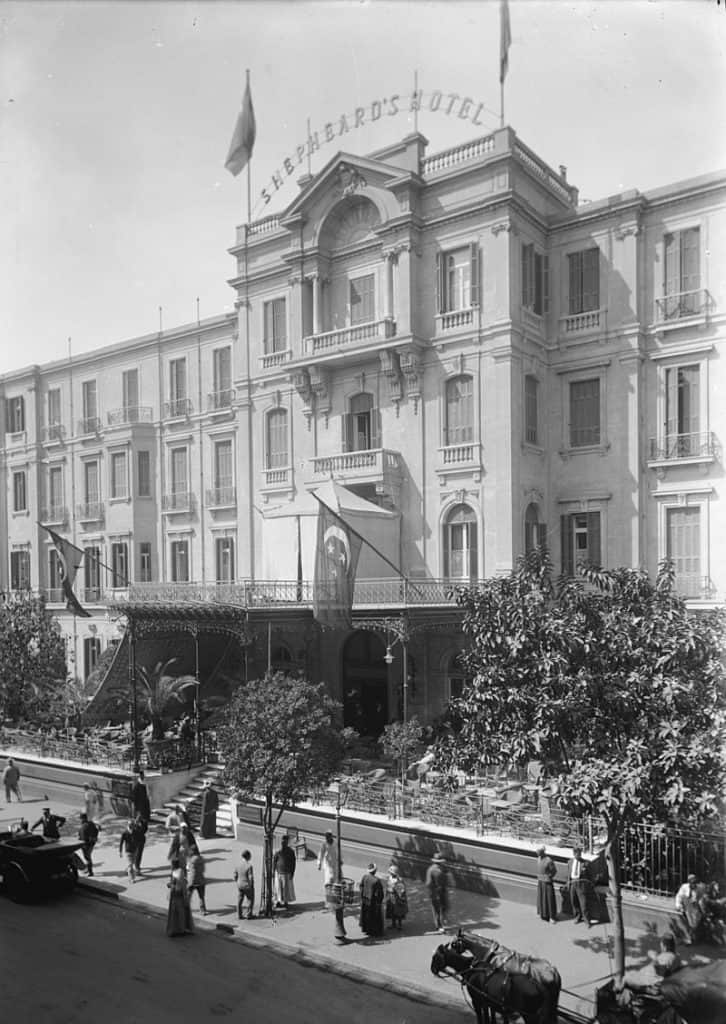
The Shepheard Hotel was famous for its opulence, with stained glass, Persian carpets, gardens, terraces, and huge columns resembling ancient Egyptian temples. It was not only the Americans who frequented the American pub at the hotel but also the French and British officers. There were nightly dance parties where men appeared in army uniforms and women in evening gowns.
The pub was known as the “Long Row” because it was always crowded and required a wait for a drink.
In 1941-42, there were real fears that Rommel’s armies might reach Cairo. Among the British and Australian soldiers waiting in line for service, a joke spread: “Wait until Rommel gets to Shepherd, that’ll stop him.” The tavern’s signature cocktail was a remedy to the suffering of soldiers who complained about the poor quality of the wines in these areas. During the fighting, Nazi General Rommel would claim “I will drink champagne in Shepherd’s main wing soon”.
The “Long Row” was popular with the Greek government-in-exile, and Harold Macmillan wrote on August 21, 1944: “The government must move to Italy to escape the poisonous atmosphere of intrigue that fills Cairo. All the previous Greek governments went bankrupt at Shepherd’s Tavern.“
Across the street from the hotel were tourist shops and there was a storeroom where officers could leave their baggage.
In the mid-20th century, the food served at the hotel was described as “like anything good at the Ritz in Paris, or Adlon in Berlin, or the Grand in Rome”.
Many distinguished guests stayed at the hotel and it was the set of many international films as well. The British film “Beauty Is Coming” was shot there in 1934. The hotel was the location for some scenes of the 1996 film “The Sick Englishman,” but the main scenes of the film were shot at the Grand Hotel de Ban in Venice Lido, Italy. The hotel also inspired Agatha Christie’s novel The Crooked House.
The modern Shepheard Hotel that exists today was established in 1957 by the Egyptian Hotels Company Ltd. in the Garden City of Cairo about half a mile from the original hotel. The new hotel and the land on which it is built are owned by the Egyptian General Company for Tourism and Hotels. The hotel is managed by Helnan International Hotels Company, so the hotel is known as Helnan Shepherd.
Belmont Building
The Belmont Building is a skyscraper overlooking the Nile in Garden City. The 31-story building was designed by Naeem Shebib and completed in 1958. At the time of its construction, it was the tallest building in Egypt and Africa.
The building hosted a large advertisement for Belmont cigarettes on its rooftop, which is why it gained its current name.
How to Get to Garden City
If you take the taxi to Garden City, ask the driver to take you to Qasr al-Aini street which runs from Garden City to Tahrir Square going through the heart of Garden City.
You can also take the metro through Sadat Station at Tahrir Square downtown and walk along the Corniche until you get there.
Why Visit Garden City, Cairo
Garden City is a well-known district in Cairo, which has plenty of locations to explore, whether you’re looking for old buildings or modern activities, Garden City has a lot to offer for everyone who wants to visit it.
For more information on Cairo, check out our ultimate Egyptian vacation planner.



